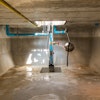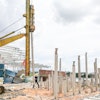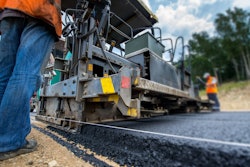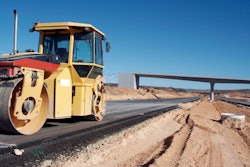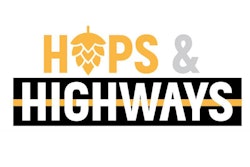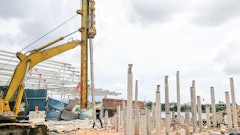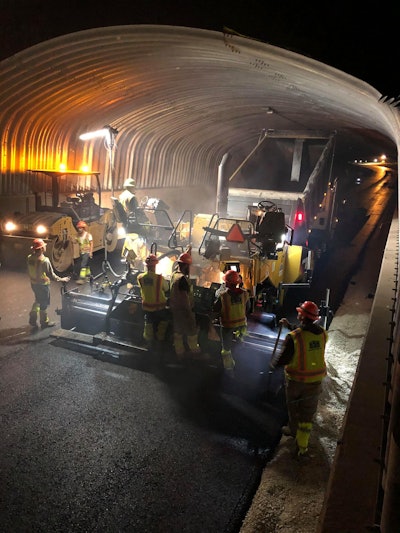
According to the American Road & Transportation Builders Association, one in three bridges in the United States are structurally deficient. That means there are 178 million daily crossings by Americans on over 46,100 structurally deficient bridges. Of the 24,494 bridges in the state of Missouri, 2,146, or 8.8 percent, are classified as structurally deficient.
In 2019, the state began I-44 Project Bridge Rebuild. The goal of the project was to repair 19 bridges along Interstate 44 in the southwest portion of the state.
Focus on the I-44 infrastructure was critical to the state as it is a significant national freight route, carrying more than 230 million tons of freight worth over $433 billion. More than 1.3 million jobs nationwide depend on I-44 in Missouri and more than 35 percent of through-freight originates from as far as Arizona, California and Texas. In 2015, Missouri had the sixth highest percentage of combination trucks utilizing its interstates in the nation.
The existing bridges on the route were built as part of original I-44 construction in the 1960s and the bridges were deteriorating, requiring major work to keep them safe for travel.
"For Project Bridge Rebuild, we offered up 31 bridges within the project limits for design-builders to consider," Greg Chapman, southwest district construction and materials engineer at the Missouri Department of Transportation (MODOT) says. "The contract amount was established to be $31.1 million. We knew there was no way to address all 31 bridges with the dollars available, however, we wanted to address as many as possible in the poorest condition. We created innovative scoring criteria that allotted the highest amount of points for addressing the bridges in the poorest condition. This methodology directed teams to focus on the poorest bridges first as they worked their way through the list. This approach put us in line with our goal to maximize as many of the worst condition bridges within the contract amount."
Ten of the bridges identified for repair on Project Bridge Rebuild were already in poor condition. In addition, nine (9) others were on the verge of being classified as in poor condition.
In April of 2019, Emery Sapp & Sons (ESS) was selected to complete the work on this design build job. They were to improve the 19 bridges along 30 miles of I-44 between Sarcoxie and Halltown. The work required them to replace 13 bridges completely and rehabilitate six more. The job had a $31,100,000 design and construction budget and was scheduled for completion by December 15th, 2020. The crew completed the work November 15th, 2020, a month earlier than expected and a full year earlier than the original completion date proposed by MODOT.
A project of this type that spans across multiple seasons however, is bound to encounter it’s fair share of problems and the crew at ESSs rose to the challenge of each one.
Keeping the Flow of Traffic
Coordination and communication are keys to success when trying to coordinate a project of this size. During work, ESS had to keep at least one lane of I-44 open in each direction at all times and maintaining the flow of traffic was a challenge.
“I-44 is one of the busiest roads in the state and is the largest freight corridor,” Jeremy Bexten, project manager at ESS says. “With the number of big trucks traveling the route at all hours, maintaining traffic flow was tough. We were able to work the MODOT and the Highway Patrol to successfully get the work down while minimizing traffic impacts.”
ESS deployed the largest smart work zone ever implemented in the State of Missouri. They used message boards spread from West of Joplin to East of Springfield that would alert motorists well in advance if any delays were occurring.
"This was extremely helpful on the large travel holidays and weekends," Bexten adds. "With major colleges and easy access to tourist destinations traveling down I-44, those routine travelers relied on those dynamic and always changing messages to get them to the fast route around the back ups."
These message boards and cameras were also made accessible to the highway patrol, so they could quickly identify the cause of the back up and clear the accident or respond to the scene if needed.
ESS also utilized intuitive segment configurations to help with work zone safety.
"These bridge bundles were paired with the largest smart work zones our district has seen," Chapman says. "The segmentation of the project allowed the contractor to bundle multiple bridges under one traffic control set up, maximizing efficiency, saving time and minimizing impact to drivers. The smart work zones utilized 36 electronic message boards strategically placed along the entire 30-mile length of the project, alerting drivers to traffic delays and directing them to alternative routes when necessary. This provided for the least impact to traffic, and improved safety and access for emergency responders."
Route 96 Challenges
While most of this project involved the ESS excavation, grading and bridge construction crews, the asphalt paving division did self-perform work in several areas, including under a corrugated structure in the cities of Halltown and Mt. Vernon.
“A majority of this project was bridge replacements with minimal grade and pavement changes,” Bexten says. “A couple locations, like Route H in Mt. Vernon and Route 96 in Halltown, had vertical clearance issues that were able to be corrected by lowering the road under the bridges. One of our major innovations on the job was the use of a corrugated steel arch in place of replacing four bridges.This removed four future maintenance issues from MODOT's list and reduced the cost of construction.The life on these structures will be longer than a standard new bridge in these locations.”
The Route 96, location where one of these arches was to be installed, posed several challenges for the crew. The first one being the actual geometry of the roadway.
“The existing roadway is on a curve and has a non-traditional ramp layout,” Bexten says. “This creates confusion and slows traffic down in the area. Because of the curve in the interstate, we were not able to raise the grade of I-44 to create the clearance we needed to get the arch under the existing bridges. We decided to lower Route 96 instead.”
In doing that, ESS ran into solid rock about 3-ft. above the elevation they needed to get to. The crew improvised and brought in a blasting subcontractor to loosen up the rock. After blasting was complete in May, the crews then discovered this area had a very high water table and were forced to pump water almost non-stop until the arch construction was complete.
“Lowering Route 96 ended up being a major challenge,” Bexten says. “Once the excavation was complete, we keyed the footings of the arch into rock and built the arch. The arch construction was supposed to be the hardest part of this location but it ended up going very smoothly. Once the arch was complete, we backfilled the arch and paved the asphalt through the arch. We did concrete paving over the arch to provide some extra support to the fill over the arch where the backfill was thinner than normal.”
Paving underneath these structures also posed a few challenges for the asphalt division.
The previous pavement was removed by the ESS crew while they were lowering the roadway. They milled off the pavement and used a pavement hammer to break up the concrete that was underneath.
“During paving, we struggled with the fact that the dump trucks couldn't raise their beds completely inside the arch,” Bexten says. “We were usually able to dump about 3/4 of the load at the paver and the rest needed to be packed in.”
ESS used a pavement design of 9-in. of asphalt on 4-in. of base for a total tonnage of 2,100 tons.
On this one section of the entire I-44 project, the ESS team encountered under pavement problems which initially caused significant schedule impacts. The team worked six to seven days a week through August and September to fast-track construction and make sure this portion of the project finished on time.
Challenges Don’t Stop Production
Because ESS was able to self-perform the asphalt paving work, they could make up some of the time initially lost due to the previous challenges they encountered. By completing this work with their own asphalt division, ESS was also able control the timeline that it needed to be completed, speeding up construction while also ensuring the quality of the work.
Additionally, like many companies, ESS experienced short-term shutdowns due to COVID-19. ESS pushed through these challenges to make sure they were able to open Route 96 as soon as possible.
The entire project was completed on December 15th, 2020 and ESS will warranty the work for one year, handling any issues that may arise before the one-year inspection.
MODOT says the total programmed amount for this job was $36.1 million and it's anticipated the project will come in under budget by approximately $1.5 million.
"This project was a true success for MoDOT," Chapman says. "We addressed a large number of bridges in definite need on one of our most critical roadways, while improving safety at the same time. The project was completed ahead of schedule and under budget."
MODOT says that one of the reasons the project was so successful was due to the communication with the team at ESS.
"One of the biggest keys to success was establishing team goals and making sure all decisions were based on those goals," Chapman says. "Partnering was also a huge key to success. In addition, high levels of communication were imperative to ensure issues were resolved timely, team members were consistently informed of project events and issues, and schedule discussions consistently had to take place to ensure we delivered the project on time to our customers."
ESS considers this project a huge success for their company as well and despite the challenges this project held for the crew, the team was able to overcome each one and learn from their experiences.
“Don't underestimate the unknowns on a design-build job,” Bexten says. “When a contractor assumes the risk of the design, they need to be prepared for anything. We encountered water and rock where we shouldn’t have encountered them. We also hit an area where piling was supposed to hit rock at about 30-ft. and it ended up going over 100-ft. before it hit. We had railroad delays, COVID-related challenges, flooding and snow. When you have a job that lasts multiple years and several seasons, you can expect to see everything.”


